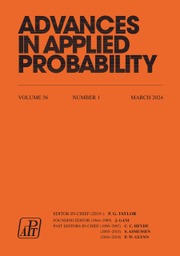Article contents
A dual risk model with additive and proportional gains: ruin probability and dividends
Published online by Cambridge University Press: 08 February 2023
Abstract
We consider a dual risk model with constant expense rate and i.i.d. exponentially distributed gains  $C_i$ (
$C_i$ ( $i=1,2,\dots$) that arrive according to a renewal process with general interarrival times. We add to this classical dual risk model the proportional gain feature; that is, if the surplus process just before the ith arrival is at level u, then for
$i=1,2,\dots$) that arrive according to a renewal process with general interarrival times. We add to this classical dual risk model the proportional gain feature; that is, if the surplus process just before the ith arrival is at level u, then for  $a>0$ the capital jumps up to the level
$a>0$ the capital jumps up to the level  $(1+a)u+C_i$. The ruin probability and the distribution of the time to ruin are determined. We furthermore identify the value of discounted cumulative dividend payments, for the case of a Poisson arrival process of proportional gains. In the dividend calculations, we also consider a random perturbation of our basic risk process modeled by an independent Brownian motion with drift.
$(1+a)u+C_i$. The ruin probability and the distribution of the time to ruin are determined. We furthermore identify the value of discounted cumulative dividend payments, for the case of a Poisson arrival process of proportional gains. In the dividend calculations, we also consider a random perturbation of our basic risk process modeled by an independent Brownian motion with drift.
MSC classification
Information
- Type
- Original Article
- Information
- Copyright
- © The Author(s), 2023. Published by Cambridge University Press on behalf of Applied Probability Trust
References
- 2
- Cited by


